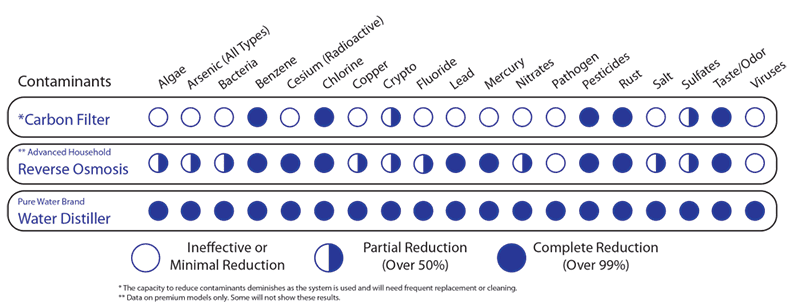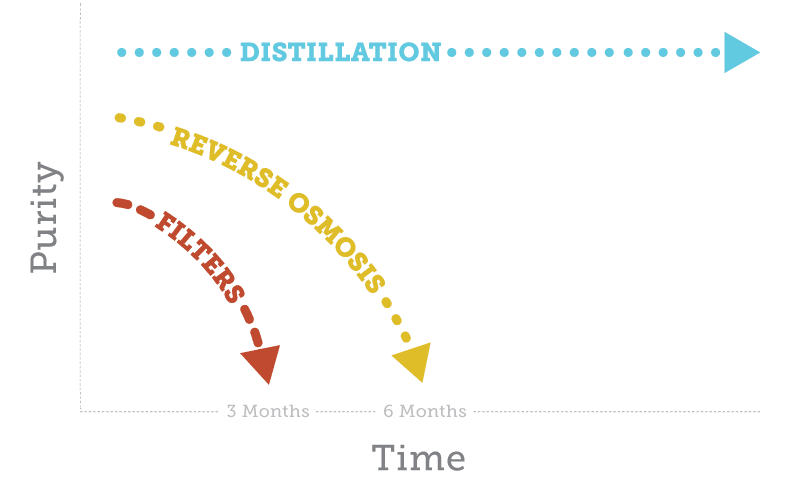In today’s world, access to clean, safe drinking water is more crucial than ever. With increasing concerns about contaminants, pollutants, imposed health risks, and the overall quality of our water sources, it’s essential to understand the most effective methods for ensuring the purity of the water we consume. Among the various purification methods available, water distillation reigns supreme by consistently producing the highest quality of water. In this comprehensive guide, we’ll explore what makes water distillation unique, how it works, and all the benefits.
What is Water Distillation?
Water distillation is a process that replicates how the Earth naturally purifies water. This process purifies water by heating it to create steam vapor, and then cooling the steam to condense it back into the liquid state of water.

This method leverages the principle that water boils at a lower temperature than most impurities and contaminants. By converting water into steam, distillation separates it from impurities that are left behind in the boiling chamber.
The Distillation Process
1. Boiling
The first step in the distillation process involves heating the water to its boiling point, typically 100°C (212°F). This phase is crucial as it transforms the liquid water into steam while leaving behind contaminants, minerals, and other substances with higher boiling points.
2. Vaporization
As the water boils, it turns into steam, which is essentially pure H2O. The impurities and contaminants, which generally have higher boiling points, remain in the original container.
3. Condensation
The steam is then directed through a cooling system where it cools and condenses back into liquid form. This condensed liquid is now free of the majority of impurities and is collected as distilled water.
4. Collection
The final step involves collecting the distilled water in a clean container, ensuring that it remains uncontaminated until it’s used.
Why Choose Distilled Water?
Distilled water offers several distinct advantages over other water purification methods. Let’s delve into some of the key benefits:
Purity
One of the most significant benefits of distillation is the level of purity it achieves. Distilled water is free from most contaminants, including bacteria, viruses, salts, and heavy metals. This makes it an excellent choice for applications where high purity is essential, such as in medical settings, laboratories, and certain industrial processes.
Removal of Impurities
Distillation effectively removes both organic and inorganic impurities. Unlike other filtration methods that may only target specific contaminants, distillation addresses the entire range of potential impurities. This makes it the absolute best solution for ensuring water quality.
Protection from Contaminant Health Risks
As more studies continue, contaminants commonly found in your water supply can lead to serious health concerns. To list just a few, health risks have been associated with consuming contaminants such as lead, arsenic, uranium, nitrates, chlorine, fluoride, pesticides, PFAS, biological bacteria, and many others. By removing these contaminants through the distillation process, you can protect the health of your household.
Consistency
The distillation process produces consistently high-quality water. Unlike some filtration methods that may degrade over time or require frequent maintenance, distillation systems can provide a steady supply of pure water with minimal variability.
No Chemical Additives
Distillation doesn’t rely on chemicals or additional additives to purify water. This makes it an ideal option for those who prefer to avoid the use of chemical treatments in their water purification process.
Improved Taste
Many people find distilled water to have a cleaner, crisper taste compared to tap water or water filtered by other methods. This is because the distillation process removes many of the substances that can affect flavor, including chlorine and certain minerals.
View Our 3rd Party Lab Test Results for Contaminant Removal
Distillation vs. Other Purification Methods
As you know by now, distillation is a form of water purification and is the most effective by removing over 99.9% of contaminants found in your water supply. While distillation is highly effective, it’s important to understand other water purification methods and each of their unique strengths and possible weaknesses.
- Boiling: Heating water to a rolling boil for at least one minute kills bacteria, viruses, and other pathogens, making it safer to drink.
- Filtration: This involves passing water through a filter to remove impurities and contaminants. Filters can vary in their pore size and material, targeting different types of contaminants.
- Chlorination: Adding chlorine or chlorine compounds to water effectively disinfects it, killing bacteria and viruses. This method is widely used in municipal water treatment.
- Reverse Osmosis: Water is forced through a semi-permeable membrane that filters out most contaminants, including particles, bacteria, and chemicals. This method is effective for reducing a broad range of impurities.
- Distillation: This process involves boiling water and then condensing the steam vapor. Distilled water is free from impurities, making it very pure. [view our 3rd party verified test results]
Water distillation represents one of the most thorough and reliable methods for ensuring the purity of your water. By leveraging the principles of boiling and condensation, distillation effectively removes a wide range of contaminants, providing you with clean, high-quality water. Distilled water offers a consistent and trustworthy solution to maintaining water purity in comparison to other purification methods.
Understanding the distillation process and its benefits can help you make informed decisions about your water purification needs. As with any purification method, it’s essential to evaluate your specific requirements and consider how distillation aligns with your goals for water quality. With its proven effectiveness and wide-ranging applications, water distillation remains a top choice for those seeking the highest level of water purity.






What is the needed maintenance?
General maintenance includes monthly descaling of the boiling tank and quarterly changes of the post carbon filters. The timing can vary with the quality of your source water.